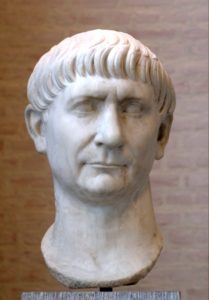 Rome’s popular 13th emperor is getting a new exhibit detailing his life and legacy, in time for the 1900th anniversary of his death. Trajan, who ruled the Roman Empire from 98 to 117 A.D., was referred to as the optimus princeps (the best ruler) by the senate at the time. He is most known for his military victories in the expansion of the Roman Empire to its largest state, from the Irish Sea to the Black Sea and into North Africa, and for implementing public building projects and social programs.
Rome’s popular 13th emperor is getting a new exhibit detailing his life and legacy, in time for the 1900th anniversary of his death. Trajan, who ruled the Roman Empire from 98 to 117 A.D., was referred to as the optimus princeps (the best ruler) by the senate at the time. He is most known for his military victories in the expansion of the Roman Empire to its largest state, from the Irish Sea to the Black Sea and into North Africa, and for implementing public building projects and social programs.
The exhibit, called “Trajan, Building an Empire, Creating Europe,” is open now through Sept. 16, 2018 in Rome at Trajan’s Market at the Imperial Forum. It details Trajan’s legacy, including his military conquests, a welfare program for children and tax collection. Besides his military-led expansion of Roman territory, Trajan presided over periods of peace and unity throughout the Roman Empire.
“He was plenty violent in terms of warfare, but not like Caligula or Nero,” Mary T. Boatwright, a professor of ancient history in the department of classical studies at Duke University, told the San Francisco Chronicle. “He wasn’t a tyrant.”
Trajan was born in present-day Spain in 53 A.D. – the first Roman emperor who wasn’t Italian – and was buried in Rome. Trajan’s Forum, part of the Imperial Fora, was built in 112 A.D. from materials looted from Dacia, an area on the Black Sea surrounding present-day Romania that the Romans conquered in 106 A.D. A carved frieze that spirals up the almost-100-foot-high Trajan’s Column, part of the Forum, illustrates the military campaign in Dacia.
The women in Trajan’s life are sometimes seen as precursors to modern American first ladies: His wife, Plotina, as well as his sister and niece charitably donated money to landowners to develop their land for farming and use the income to support their children. Plotina was also something of a fashion icon, as her upswept crown of hair was a popular style that many women copied.
“With Trajan we are beginning to see what we moderns see as bureaucracy,” said Boatwright.
Claudio Parisi Presicce, superintendent of Rome’s Capitoline Museums, had the idea for the exhibit, while Lucrezia Ungaro, Marina Milella and Simone Pastor curated it. The exhibit shows his private side, including his love of wine and sex (he is rumored to have had several male lovers), and items found in his residence.
The exhibit is divided into seven sections that feature casts, models, multimedia, and other works dedicated to themes such as the important role of women in Trajan’s life, his military clashes, the infrastructure of the 5 million-square-kilometer (1.9 million-square-mile) empire, and the emperor’s posthumous fortune.
Among the objects on display are fragments of frescoes from Trajan’s villa at Arcinazzo Romano, west of Rome, as well as jewels. Visitors can get up close to sculptures and casts of monuments such as the Arch of Ancona, the bridge over the Danube River and a scale model of the battle at Dacia.
Through a video, the experience takes guests underground into Trajan’s villa under Aventine Hill and into the aqueduct he built to transport water to Trastevere from Lake Bracciano, 20 miles northwest of Rome.
By Kathy McCabe
